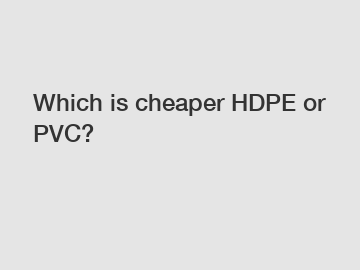Which is cheaper HDPE or PVC?
When it comes to choosing the right material for your piping needs, two popular options that come to mind are High-Density Polyethylene (HDPE) and Polyvinyl Chloride (PVC). Both materials have their own set of benefits and drawbacks, but one burning question that often comes up is: which is cheaper - HDPE or PVC?
To answer this question, we must take into consideration various factors that influence the overall cost of using these materials. Let's break it down and compare the two based on their cost-effectiveness.
One of the key factors that influence the cost of HDPE and PVC is the initial cost of the materials themselves. HDPE is typically known for being more expensive than PVC due to its higher manufacturing costs. However, despite the higher initial cost, HDPE is often considered more cost-effective in the long run due to its durability and resistance to corrosion and chemicals. This means that although you may pay more upfront for HDPE piping, you may end up saving money on maintenance and replacement costs down the line.

On the other hand, PVC is generally cheaper upfront compared to HDPE. PVC pipes are lightweight, easy to install, and have a smooth interior surface that allows for efficient water flow. However, PVC is prone to cracking and deformation when exposed to extreme temperatures, making it less durable than HDPE. This means that while PVC may be cheaper initially, you may end up spending more on repairs and replacements over time.
Another factor to consider when comparing the cost of HDPE and PVC is the installation process. HDPE pipes are typically installed using heat fusion, which requires specialized equipment and trained professionals. This can add to the installation cost of HDPE piping. In contrast, PVC pipes are usually installed using solvent cement, which is a simpler and more cost-effective process. This means that the installation cost of PVC piping is often lower compared to HDPE.
Additionally, the maintenance and lifespan of HDPE and PVC pipes should also be taken into account when determining their cost-effectiveness. HDPE pipes have a longer lifespan and require less maintenance compared to PVC pipes. HDPE is resistant to corrosion, abrasion, and chemicals, making it an ideal choice for applications where longevity is a primary concern. PVC pipes, on the other hand, are more vulnerable to damage and may require more frequent repairs and replacements.
In terms of environmental impact, HDPE and PVC have different sustainability profiles that can affect their overall cost. HDPE is a more environmentally friendly option compared to PVC due to its recyclability and low carbon footprint. HDPE pipes can be recycled and reused, reducing the need for new raw materials and energy consumption. PVC, on the other hand, is not as easily recyclable and has a higher environmental impact during production and disposal.
In conclusion, while HDPE may be more expensive upfront compared to PVC, it offers long-term cost savings due to its durability, resistance to corrosion, and low maintenance requirements. HDPE is also a more sustainable option with a lower environmental impact compared to PVC. However, the final decision on which material is cheaper ultimately depends on your specific needs and budget constraints. It is essential to carefully consider the long-term benefits and drawbacks of HDPE and PVC before making a decision.
If you are looking for more details, kindly visit hdpe floats, wholesale dredge rubber hose, hdpe dredging pipe.
212
0
0

Comments
All Comments (0)